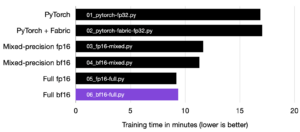As machine learning models continue to gain widespread adoption in industries ranging from healthcare and manufacturing to retail and logistics, it has become increasingly important that we evaluate their performance to ensure they are providing the desired outcomes. The following KPIs have a direct impact on end-user experience and can be used to ensure that machine learning models provide real value to the organizations using them:
1. Scalability
The ability for a machine learning model to handle increasing amounts of data or requests.As the number of users or the size of the data increases, a model that is not scalable can result in long wait times and decreased overall efficiency. The ability for a machine learning model to flexibly handle a changing number of concurrent requests without also reducing the quality of the outputs generated is crucial for businesses relying on those models to produce mission-critical predictions.
We recently covered how you can scale your model serving through dynamic batching and autoscaling, and you can also use techniques like parallel processing, distributed computing, or multi-threading.
2. Speed
The time taken by the model to process a request and return a result.In real-time applications, where quick response times are critical, slow models can result in missed opportunities or incorrect decisions. The speed of a model can be evaluated by measuring the time it takes to process a single request or a batch of requests. To improve speed, expert machine learning engineers may need to optimize the model’s architecture, reduce the size of the model, or use hardware acceleration.
Here’s how we tripled our Stable Diffusion inference speed without any observable decrease in the quality of images generated.
3. Accuracy
The ability for a machine learning model to produce correct predictions.The accuracy of a machine learning model can be evaluated using metrics such as precision, recall, and F1-score, depending on the type of problem being solved. For example, in a binary classification problem, precision measures the proportion of positive predictions that are actually positive, while recall measures the proportion of positive cases that were correctly identified by the model. For StableDiffusion, the contextual relevance and quality of the images generated is most important.
Accuracy is important for machine learning models that are used to make decisions in real-world applications where incorrect results can have significant consequences. Expert machine learning engineers must ensure that the models they develop are accurate, and that their accuracy remains consistent over time.
Learn more about how PyTorch Lightning supports mixed precision training to scale larger models and enables you to take advantage of optimized accelerators.
4. Cost
The financial cost of developing, training, and deploying a machine learning model.The cost of a machine learning model is not limited to its development, as ongoing costs such as maintenance, hardware, and infrastructure also play a role in their lifetime cost. Expert machine learning engineers must balance the benefits of deploying a model against its costs to ensure that it provides real value to the organization. To minimize cost, machine learning teams may need to optimize the training process, use cloud-based solutions, or consider alternative hardware solutions.
The Lightning Platform enables you to leverage third-party tools alongside dozens of optimizations to manage the cost of deploying your model.
5. Interpretability
The ability for a machine learning model to provide insights into why it is making a particular prediction.This is especially important in applications where the consequences of incorrect predictions can be significant, as it allows engineers to detect and correct any errors. To improve interpretability, the teams deploying models may need to leverage techniques such as feature importance, partial dependence plots, or decision trees.
By focusing on these KPIs, machine learning practitioners can contribute to the success of the models they deploy and ensure that they are providing real value to the organizations using them.
Wrap-up
Leveraging machine learning models in production requires the teams deploying them to navigate a fine line between managing the performance of those models (their ability to handle multiple requests for high-quality outputs) and the financial weight of deploying them (how much it costs to keep a suitably performant model running and available for inference). The Lightning Platform allows users to take advantage of dozens of optimizations that help you manage the cost and performance of using a machine learning model in your business, research, or project.
Want to get started building something awesome with machine learning? Creating a Lightning account gets you $30USD worth of credits every month that you can use towards cloud compute.
